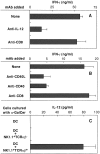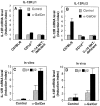The natural killer T (NKT) cell ligand alpha-galactosylceramide demonstrates its immunopotentiating effect by inducing interleukin (IL)-12 production by dendritic cells and IL-12 receptor expression on NKT cells
- PMID: 10190903
- PMCID: PMC2193012
- DOI: 10.1084/jem.189.7.1121
The natural killer T (NKT) cell ligand alpha-galactosylceramide demonstrates its immunopotentiating effect by inducing interleukin (IL)-12 production by dendritic cells and IL-12 receptor expression on NKT cells
Abstract
The natural killer T (NKT) cell ligand alpha-galactosylceramide (alpha-GalCer) exhibits profound antitumor activities in vivo that resemble interleukin (IL)-12-mediated antitumor activities. Because of these similarities between the activities of alpha-GalCer and IL-12, we investigated the involvement of IL-12 in the activation of NKT cells by alpha-GalCer. We first established, using purified subsets of various lymphocyte populations, that alpha-GalCer selectively activates NKT cells for production of interferon (IFN)-gamma. Production of IFN-gamma by NKT cells in response to alpha-GalCer required IL-12 produced by dendritic cells (DCs) and direct contact between NKT cells and DCs through CD40/CD40 ligand interactions. Moreover, alpha-GalCer strongly induced the expression of IL-12 receptor on NKT cells from wild-type but not CD1(-/-) or Valpha14(-/-) mice. This effect of alpha-GalCer required the production of IFN-gamma by NKT cells and production of IL-12 by DCs. Finally, we showed that treatment of mice with suboptimal doses of alpha-GalCer together with suboptimal doses of IL-12 resulted in strongly enhanced natural killing activity and IFN-gamma production. Collectively, these findings indicate an important role for DC-produced IL-12 in the activation of NKT cells by alpha-GalCer and suggest that NKT cells may be able to condition DCs for subsequent immune responses. Our results also suggest a novel approach for immunotherapy of cancer.
Figures






References
-
- Fowlkes BJ, Kruisbeek AM, Ton-That H, Weston MA, Coligan JE, Schwartz RH, Pardoll DM. A novel population of T-cell receptor αβ-bearing thymocytes which predominantly express a single Vβ gene family. Nature. 1987;329:251–254. - PubMed
-
- Kawano T, Cui J, Koezuka Y, Toura I, Kaneko Y, Motoki K, Ueno H, Nakagawa R, Sato H, Kondo E, Koseki H, Taniguchi M. CD1d-restricted and TCR-mediated activation of Vα14 NKT cells by glycosylceramides. Science. 1997;278:1626–1629. - PubMed
-
- Kobayashi E, Motoki K, Uchida T, Fukushima H, Koezuka Y. KRN7000, a novel immunomodulator, and its antitumor activities. Oncol Res. 1995;7:529–534. - PubMed
-
- Kazuhiko M, Maeda K, Ueno H, Kobayashi E, Uchida T, Fukushima H, Koezuka Y. Antitumor activities of combined treatment with a novel immunomodulator, (2S,3S,4R)-1-O-(α-d-galactopyranosyl)-2-(N-hexacosanoylamino)-1,3,4-octadecanetriol (KRN7000), and radiotherapy in tumor-bearing mice. Oncol Res. 1996;8:155–162. - PubMed
Publication types
MeSH terms
Substances
LinkOut - more resources
Full Text Sources
Other Literature Sources
Molecular Biology Databases
Research Materials

